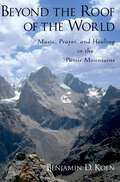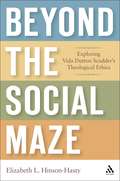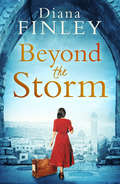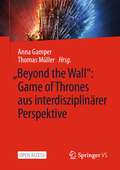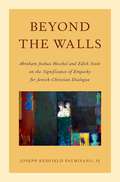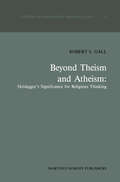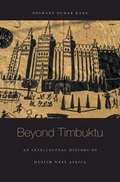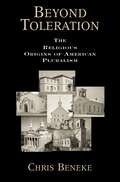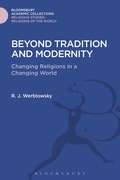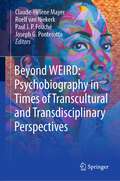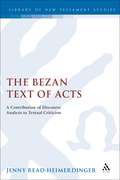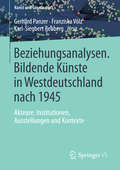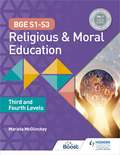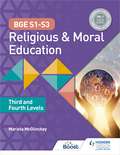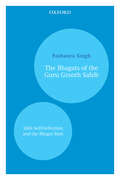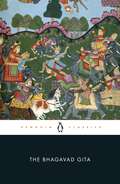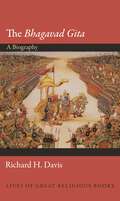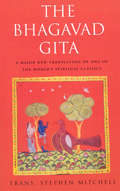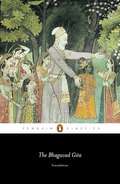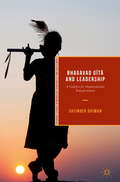- Table View
- List View
Beyond the Roof of the World: Music, Prayer, and Healing in the Pamir Mountains
by Benjamin D. KoenWhile Western medicine has conventionally separated music, science, and religion into distinct entities, traditional cultures throughout the world have always viewed music as a bridge that connects the physical with the spiritual. Now, as people in even the most technologically advanced nations across the globe struggle with obtaining affordable and reliable healthcare coverage, more and more people are turning to these ancient cultural practices of ICAM healing (integrative, complementary, and alternative medicine). With Beyond the Roof of the World, Dr. Benjamin D. Koen unearths the Western separation of healing from spiritual and musical practices as a culturally determined phenomenon, and proves the relevance of medical ethnomusicology in light of the globally spreading ICAM healing practices. Using the culture found within the towering Pamir Mountains of Badakhshan Tajikistan, in a place poetically known as the Roof of the World, as the paradigm of ICAM healing, Koen shows spirituality and musicality to be intimately intertwined with one's physical life, health and healing. For the first time, Koen bridges the widespread gap between ethnomusicology and music therapy. Koen's extensive research and emersion into the Badakhstan culture provides the reader with an "insider" perspective while maintaining an "observer's" view, as he infuses the text with relevant scholarship.
Beyond the Roof of the World: Music, Prayer, and Healing in the Pamir Mountains
by Benjamin D. KoenWhile Western medicine has conventionally separated music, science, and religion into distinct entities, traditional cultures throughout the world have always viewed music as a bridge that connects the physical with the spiritual. Now, as people in even the most technologically advanced nations across the globe struggle with obtaining affordable and reliable healthcare coverage, more and more people are turning to these ancient cultural practices of ICAM healing (integrative, complementary, and alternative medicine). With Beyond the Roof of the World, Dr. Benjamin D. Koen unearths the Western separation of healing from spiritual and musical practices as a culturally determined phenomenon, and proves the relevance of medical ethnomusicology in light of the globally spreading ICAM healing practices. Using the culture found within the towering Pamir Mountains of Badakhshan Tajikistan, in a place poetically known as the Roof of the World, as the paradigm of ICAM healing, Koen shows spirituality and musicality to be intimately intertwined with one's physical life, health and healing. For the first time, Koen bridges the widespread gap between ethnomusicology and music therapy. Koen's extensive research and emersion into the Badakhstan culture provides the reader with an "insider" perspective while maintaining an "observer's" view, as he infuses the text with relevant scholarship.
Beyond the Social Maze: Exploring Vida Dutton Scudder's Theological Ethics
by Elizabeth L. Hinson-HastyBeyond the Social Maze is the first thoroughgoing exploration of Vita Dutton Scudder's theological ethics. She taught at Wellesley College for more than forty years and chartered new territories in both theoretical and practical aspects of movements for social reform. She was deeply concerned about the role that Christians should play in alleviating social distress, and she considered herself part of a broad coalition of enlightened Protestants who directed the attention of churches toward their moral obligation to mitigate the hardship of the working class. Societal restrictions prevented Scudder from considering a professional career as a priest or seminary professor; nonetheless, a highly developed theological vision inspired her passion for social reform, socialist causes, and commitment to and involvement in the church. Historians and theologians have paid too little attention to the theological vision that fueled Scudder's social ethics. Hinson-Hasty remedies that. She demonstrates the ways that Scudder brought a distinctive perspective to bear on the social gospel project. Her theological perspective differed from that of Walter Rauschenbusch, the most famous proponent of the movement. Like him, she aimed to rally Christian energies to work toward transforming society in light of a commitment to the Kingdom of God. However, unlike Rauschenbusch, who emphasized the teaching of Jesus and the prophets, an explicit trinitarian emphasis informed Scudder's understanding of the Kingdom and her social outlook. She appealed to Divine Society as a model for justice and equality in her own context. Her distinctive vision integrated her Anglican theological convictions with an impulse toward practical reform.
Beyond the Storm
by Diana Finley‘Phenomenal… Beautifully written and emotionally charged. I cried… Outstanding.’ NetGalley reviewer, 5 stars An epic tale of love, war, and the secrets we keep…
„Beyond the Wall”: Game of Thrones aus interdisziplinärer Perspektive
by Anna Gamper Thomas MüllerDieses Open-Access-Buch beleuchtet das Serienphänomen „Game of Thrones“ aus unterschiedlichen wissenschaftlichen Perspektiven: Die rechtswissenschaftliche trifft auf die sprach-, musik-, literatur- und sozialwissenschaftliche, ferner die (kunst-)historische, psychologische und theologische Perspektive. Die Beiträge zeigen auf, dass die Serie reiche Anknüpfungspunkte für die wissenschaftliche Forschung unterschiedlichster Fachrichtungen bietet, die auch dazu anregen, sprichwörtlich „beyond the wall“ zu denken. Das Buch spricht dabei sowohl ein interdisziplinäres wissenschaftliches Publikum als auch sonstige Fans der Serie an.
Beyond the Walls: Abraham Joshua Heschel and Edith Stein on the Significance of Empathy for Jewish-Christian Dialogue
by Joseph PalmisanoJoseph Palmisano explores the interreligious significance of empathy for Jewish-Christian understanding. Drawing on the writings of Rabbi Abraham Joshua Heschel (1907-1972) and Edith Stein (1891-1942), he develops a phenomenological category of empathy defined as a way of ''re-membering'' oneself with the religious other.
Beyond Theism and Atheism: Heidegger’s Significance for Religious Thinking (Studies in Philosophy and Religion #11)
by R.S. GallMy first year in graduate school marked by initial expo sure to Heidegger and some of his important early essays. At tha~ time, disenchanted with the state in which "religious thought" lay, I was quickly struck by the potential Heidegger presented for breaking new ground in a field that had seeming ly exhausted itself by reworking the same old issues and answers. That insight, along with the conviction that Heideg ger had been misused and misunderstood by theologians and religious thinkers ever since he burst upon the intellectual scene with the publ ication of Sein und Zei t, grew throughout my graduate career and resulted in a dissertation on Heidegger and religious thinking, of which the present text is a revised and updated version. This text reflects my belief that Heid egger, when "properly" understood on such matters as truth, God (and gods), and "faith", presents us with a unique voice and vision that cannot be co-opted into any sort of theology -- be it negative, existential, dialectical or Thomistic - and indeed seriously challenges the viability of any "theol ogy".
Beyond Timbuktu: An Intellectual History Of Muslim West Africa
by Ousmane Oumar KaneTimbuktu is famous as a center of learning from Islam’s Golden Age. Yet it was one among many scholarly centers to exist in precolonial West Africa. Ousmane Kane charts the rise of Muslim learning in West Africa from the beginning of Islam to the present day and corrects lingering misconceptions about Africa’s Muslim heritage and its influence.
Beyond Timbuktu: An Intellectual History Of Muslim West Africa
by Ousmane Oumar KaneTimbuktu is famous as a center of learning from Islam’s Golden Age. Yet it was one among many scholarly centers to exist in precolonial West Africa. Ousmane Kane charts the rise of Muslim learning in West Africa from the beginning of Islam to the present day and corrects lingering misconceptions about Africa’s Muslim heritage and its influence.
Beyond Toleration: The Religious Origins of American Pluralism
by Chris BenekeAt its founding, the United States was one of the most religiously diverse places in the world. Baptists, Methodists, Catholics, Episcopalians, Presbyterians, Congregationalists, Quakers, Dutch Reformed, German Reformed, Lutherans, Huguenots, Dunkers, Jews, Moravians, and Mennonites populated the nations towns and villages. Dozens of new denominations would emerge over the succeeding years. What allowed people of so many different faiths to forge a nation together? In this richly told story of ideas, Chris Beneke demonstrates how the United States managed to overcome the religious violence and bigotry that characterized much of early modern Europe and America. The key, Beneke argues, did not lie solely in the protection of religious freedom. Instead, he reveals how American culture was transformed to accommodate the religious differences within it. The expansion of individual rights, the mixing of believers and churches in the same institutions, and the introduction of more civility into public life all played an instrumental role in creating the religious pluralism for which the United States has become renowned. These changes also established important precedents for future civil rights movements in which dignity, as much as equality, would be at stake. Beyond Toleration is the first book to offer a systematic explanation of how early Americans learned to live with differences in matters of the highest importance to them --and how they found a way to articulate these differences civilly. Today when religious conflicts once again pose a grave danger to democratic experiments across the globe, Beneke's book serves as a timely reminder of how one country moved past toleration and towards religious pluralism.
Beyond Tradition and Modernity: Changing Religions in a Changing World (Religious Studies: Bloomsbury Academic Collections)
by R. J. WerblowskyFirst delivered in 1974 as one of the Jordan Lectures in Comparative Religion, this book considers and compares traditional or pre-modern and post-traditional or post-modern religions. It assesses the processes as well as the images of change in various cultures – principally Christianity, Judaism, Islam, Hinduism and Buddhism – and examines how these religions handle the dialects of rejection, appropriation and integration.
Beyond WEIRD: Psychobiography in Times of Transcultural and Transdisciplinary Perspectives
by Claude-Hélène Mayer Roelf Van Niekerk Paul J. P. Fouché Joseph G. PonterottoThis volume presents psychobiographical research in non-WEIRD—Western, Educated, Industrialized, Rich and Democratic—contexts and samples, focusing on culture, transcultural and transdisciplinary work. It creates a platform for researchers, scholars and scientists from diverse backgrounds to put forth new theoretical and methodological stances in psychobiography, thereby making the field more inclusive, diverse and equitable. The chapters in this volume investigate the role of context across the life course of non-WEIRD psychological subjects, as well as the interplay between them and their environments across the life span. They further elucidate cognitive, affective and behavioural aspects of individuals with non-WEIRD backgrounds.The volume provides a broad and at the same time in-depth perspective into psychobiography beyond the usual contexts and therefore has new and original learnings to offer across disciplines and cultures. It is a breakthrough in terms of its transcultural and transdisciplinary insights into lives lived in different contexts in the world."Every person is in certain respects (a) like all other persons, (b) like some other persons, (c) like no other persons. This book is a challenging and fascinating exploration of extending psychobiography beyond its origins in Europe and America to women and men of different races and social and economic classes from Africa, Asia, and around the world. At its best, psychobiography can increase people's awareness of their own subjective experience and that of others, contributing to movements for social, cultural and political change." William McKinley Runyan, Professor Emeritus & Professor of the Graduate School, School of Social Welfare, U. of California BerkeleyBeyond Weird is beyond needed. The book triumphantly fills the gap created by a dearth of studies of people other than Western, educated, European and American men. James William Anderson, PhD, Professor of Clinical Psychiatry and Behavioral Sciences, Northwestern University, Chicago.
The Bezan Text of Acts: A Contribution of Discourse Analysis to Textual Criticism (The Library of New Testament Studies #236)
by Jenny Read-HeimerdingerThe Bezan ('Western') text of Acts is traditionally dismissed as the work of an enthusiastic and fanciful scribe who embellished the original text represented by the Alexandran manuscripts. This study compares the language of Codex Bezae with that of Codex Sinaiticus and Codex Vaticanus, using the approach of discourse analysis to re-assess how variant readings have arisen. It emerges that the language patterns of the Alexandrian text are variable and the focus of its message historical. In contrast, the Bezan text displays an exceptional degree of lingusitic consistency and a coherence of purpose which is essentially theological, with a marked interest in a Jewish point of view. The conclusion is that Bezan is the earlier of the two texts.
Beziehungsanalysen. Bildende Künste in Westdeutschland nach 1945: Akteure, Institutionen, Ausstellungen und Kontexte (Kunst und Gesellschaft)
by Gerhard Panzer Franziska Völz Karl-Siegbert RehbergAb den fünfziger Jahren entstand in Westdeutschland mit der neu geschaffenen „documenta“ allmählich das Bild einer eigenständigen „Westkunst“. Unter neuen politischen Rahmenbedingungen bewegte sich die Kunstwelt zwischen Versuchen, an Vorkriegstraditionen anzuknüpfen und sich zu modernisieren. Es kanonisierten sich abstrakte Gegenwartstendenzen, welche in der Gegensatzspannung zum Osten zunehmend politisch instrumentalisiert wurden. Von den Zeitgenossen schon kontrovers diskutiert, wird diese Phase der Kunstentwicklung bis heute unterschiedlich bewertet. Der vorliegende Band versammelt historisch-empirische Analysen, die die Beziehungsgeflechte in der damaligen Kunstwelt und deren strukturbildende, dynamische Vernetzung mit der Gesellschaft untersuchen, wobei die sozialen Träger dieser Erfolgsgeschichte im Mittelpunkt stehen.
BGE S1-S3 Religious and Moral Education: Third and Fourth Levels
by Mariela McGlincheySyllabus: CfE (Curriculum for Excellence, from Education Scotland)Level: BGE S1-3: Third and Fourth LevelsSubject: RMEModernise and refresh RME. Topics such as social media, gender identity and artificial intelligence are explored alongside world religions, as pupils think critically about our rapidly changing world.Covering all CfE Third and Fourth Level Benchmarks (plus some key content for Second Level), this ready-made and differentiated course puts progression for every pupil at the heart of your curriculum.> Ask questions and solve problems: 'Thinking skills' for later life are developed through sensitive, scaffolded consideration of Judaism, Christianity, Islam, Buddhism, Humanism and diverse and inclusive morality and belief topics that will capture every pupil's interest> Personalise the learning process: Each chapter contains learning intentions, starter tasks, explanations and activities (with accompanying success criteria) that you can deliver across one or two lessons, choosing the appropriate depth and pace for your pupils> Meet the needs of each pupil in your class: The content and activities are designed to ensure accessibility for those with low prior attainment, while 'Challenge' tasks will stretch high achieving pupils> Effectively check and assess progress: Activities that can be used for summative and formative assessment, 'progress check' questions, and suggestions for gathering a portfolio of evidence help you to monitor progression against the Experiences & Outcomes and Benchmarks> Lay firm foundations for National qualifications: The skills, knowledge and understanding established through the course will set up pupils for success in National 5 RMPS > Deliver the 'responsibility for all' Es and Os: Plenty of activities that address literacy, numeracy and health and wellbeing skills are threaded through the book
BGE S1-S3 Religious and Moral Education: Third and Fourth Levels
by Mariela McGlincheySyllabus: CfE (Curriculum for Excellence, from Education Scotland)Level: BGE S1-3: Third and Fourth LevelsSubject: RMEModernise and refresh RME. Topics such as social media, gender identity and artificial intelligence are explored alongside world religions, as pupils think critically about our rapidly changing world.Covering all CfE Third and Fourth Level Benchmarks (plus some key content for Second Level), this ready-made and differentiated course puts progression for every pupil at the heart of your curriculum.> Ask questions and solve problems: 'Thinking skills' for later life are developed through sensitive, scaffolded consideration of Judaism, Christianity, Islam, Buddhism, Humanism and diverse and inclusive morality and belief topics that will capture every pupil's interest> Personalise the learning process: Each chapter contains learning intentions, starter tasks, explanations and activities (with accompanying success criteria) that you can deliver across one or two lessons, choosing the appropriate depth and pace for your pupils> Meet the needs of each pupil in your class: The content and activities are designed to ensure accessibility for those with low prior attainment, while 'Challenge' tasks will stretch high achieving pupils> Effectively check and assess progress: Activities that can be used for summative and formative assessment, 'progress check' questions, and suggestions for gathering a portfolio of evidence help you to monitor progression against the Experiences & Outcomes and Benchmarks> Lay firm foundations for National qualifications: The skills, knowledge and understanding established through the course will set up pupils for success in National 5 RMPS > Deliver the 'responsibility for all' Es and Os: Plenty of activities that address literacy, numeracy and health and wellbeing skills are threaded through the book
The Bhagats of the Guru Granth Sahib: Sikh Self-Definition and the Bhagat Bani
by Pashaura SinghThis book offers an analysis of key issues concerning the phenomenon of scriptural adaptation. It offers a new understanding of religious pluralism, stressing the need to enter into dialogue with an 'open attitude' by honoring the individual commitments and maintaining differences in mutual respect and dignity.
Bhagavad Gita: Commentary in Tamil
by C. Subramaniya BharathiyarBhagavad Gita is a sacred Hindu scripture and is a part of the epic Mahabharatha. It is believed to be the advice of Lord Krishna to Arjuna on Dharma on the eve of Kurushetra war. Though Bhagvad Gita requires certain intellectual skill to understand the contents and message, the author in his simple style churns out the essence of Gita in an easily understandable style.
The Bhagavad Gita
by Simon BrodbeckThe Bhagavad Gita is an early epic poem that recounts the conversation between Arjuna the warrior and his charioteer Krishna, the manifestation of God. In the moments before a great battle, the dialogue sets out the important lessons Arjuna must learn to change the outcome of the war he is to fight, and culminates in Krishna revealing to the warrior his true cosmic form, counselling him to search for the universal perfection of life. Ranging from instructions on yoga postures to dense moral discussion, the Gita is one of the most important Hindu texts, as well as serving as a practical guide to living well.Translated by Laurie L. Patton
The "Bhagavad Gita": A Biography
by Richard H. DavisThe Bhagavad Gita, perhaps the most famous of all Indian scriptures, is universally regarded as one of the world's spiritual and literary masterpieces. Richard Davis tells the story of this venerable and enduring book, from its origins in ancient India to its reception today as a spiritual classic that has been translated into more than seventy-five languages. The Gita opens on the eve of a mighty battle, when the warrior Arjuna is overwhelmed by despair and refuses to fight. He turns to his charioteer, Krishna, who counsels him on why he must. In the dialogue that follows, Arjuna comes to realize that the true battle is for his own soul.Davis highlights the place of this legendary dialogue in classical Indian culture, and then examines how it has lived on in diverse settings and contexts. He looks at the medieval devotional traditions surrounding the divine character of Krishna and traces how the Gita traveled from India to the West, where it found admirers in such figures as Ralph Waldo Emerson, Henry David Thoreau, J. Robert Oppenheimer, and Aldous Huxley. Davis explores how Indian nationalists like Mahatma Gandhi and Swami Vivekananda used the Gita in their fight against colonial rule, and how contemporary interpreters reanimate and perform this classical work for audiences today.An essential biography of a timeless masterpiece, this book is an ideal introduction to the Gita and its insights into the struggle for self-mastery that we all must wage.
The "Bhagavad Gita": A Biography
by Richard H. DavisThe Bhagavad Gita, perhaps the most famous of all Indian scriptures, is universally regarded as one of the world's spiritual and literary masterpieces. Richard Davis tells the story of this venerable and enduring book, from its origins in ancient India to its reception today as a spiritual classic that has been translated into more than seventy-five languages. The Gita opens on the eve of a mighty battle, when the warrior Arjuna is overwhelmed by despair and refuses to fight. He turns to his charioteer, Krishna, who counsels him on why he must. In the dialogue that follows, Arjuna comes to realize that the true battle is for his own soul.Davis highlights the place of this legendary dialogue in classical Indian culture, and then examines how it has lived on in diverse settings and contexts. He looks at the medieval devotional traditions surrounding the divine character of Krishna and traces how the Gita traveled from India to the West, where it found admirers in such figures as Ralph Waldo Emerson, Henry David Thoreau, J. Robert Oppenheimer, and Aldous Huxley. Davis explores how Indian nationalists like Mahatma Gandhi and Swami Vivekananda used the Gita in their fight against colonial rule, and how contemporary interpreters reanimate and perform this classical work for audiences today.An essential biography of a timeless masterpiece, this book is an ideal introduction to the Gita and its insights into the struggle for self-mastery that we all must wage.
The Bhagavad Gita
by Stephen MitchellThe Bhagavad Gita, or 'Song of the Spirit', is the best known book of India's national epic The Mahabharata. Based on a dialogue between Bhagavan Krishna and Prince Arjuna on the eve of a great battle, it is held to be the essence of Hindu spirituality, sacred literature and yoga, as well as exploring the great universal themes of courage, honour, death, love, virtue and fulfilment. Of interest to the large number of contemporary spiritual seekers - of any faith and none - who want to read the world's most important sacred texts, and to learn from their wisdom. Also useful for scholars of Vedic literature and students.
The Bhagavad Gita
by Juan Mascaro NoneThe Bhagavad Gita is an intensely spiritual work that forms the cornerstone of the Hindu faith, and is also one of the masterpieces of Sanskrit poetry. It describes how, at the beginning of a mighty battle between the Pandava and Kaurava armies, thegod Krishna gives spiritual enlightenment to the warrior Arjuna, who realizes that the true battle is for his own soul.
Bhagavad Gītā and Leadership: A Catalyst for Organizational Transformation (Palgrave Studies in Workplace Spirituality and Fulfillment)
by Satinder DhimanThis book shows how the Bhagavad Gītā (part of the great Indian epic — the Mahābhārata) can be approached as a powerful tool for change management and as a catalyst for organizational transformation. It presents time-tested leadership strategies drawn from the Bhagavad Gītā that are relevant for today’s leaders. This book focuses on how to harmonize the needs of the individual with the needs of society, and by extension, how to harmonize the needs of employees and the organization. It employs an inside-out leadership development approach based on Self-knowledge and Self-mastery, the two highly important areas for practicing effective Self-leadership. The Gītā is a non-sectarian spiritual text with a universal message for living a life of meaning, purpose, and contribution and for leading from our authentic self. It shows how to manage oneself, as a necessary prelude to leading others. Students and organizational leaders will learn to integrate leadership function more effectively into all aspects at the individual, team, and institutional level.
